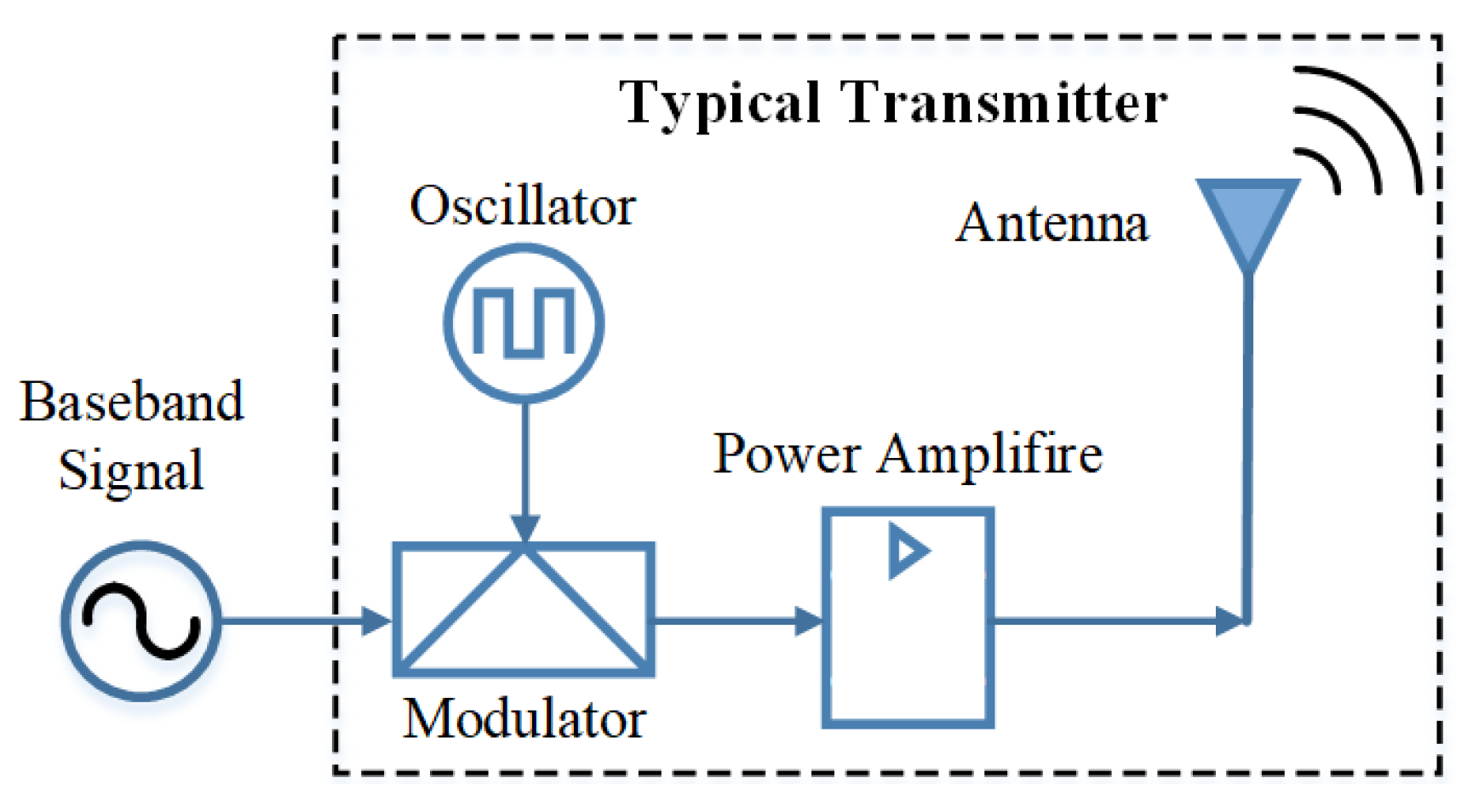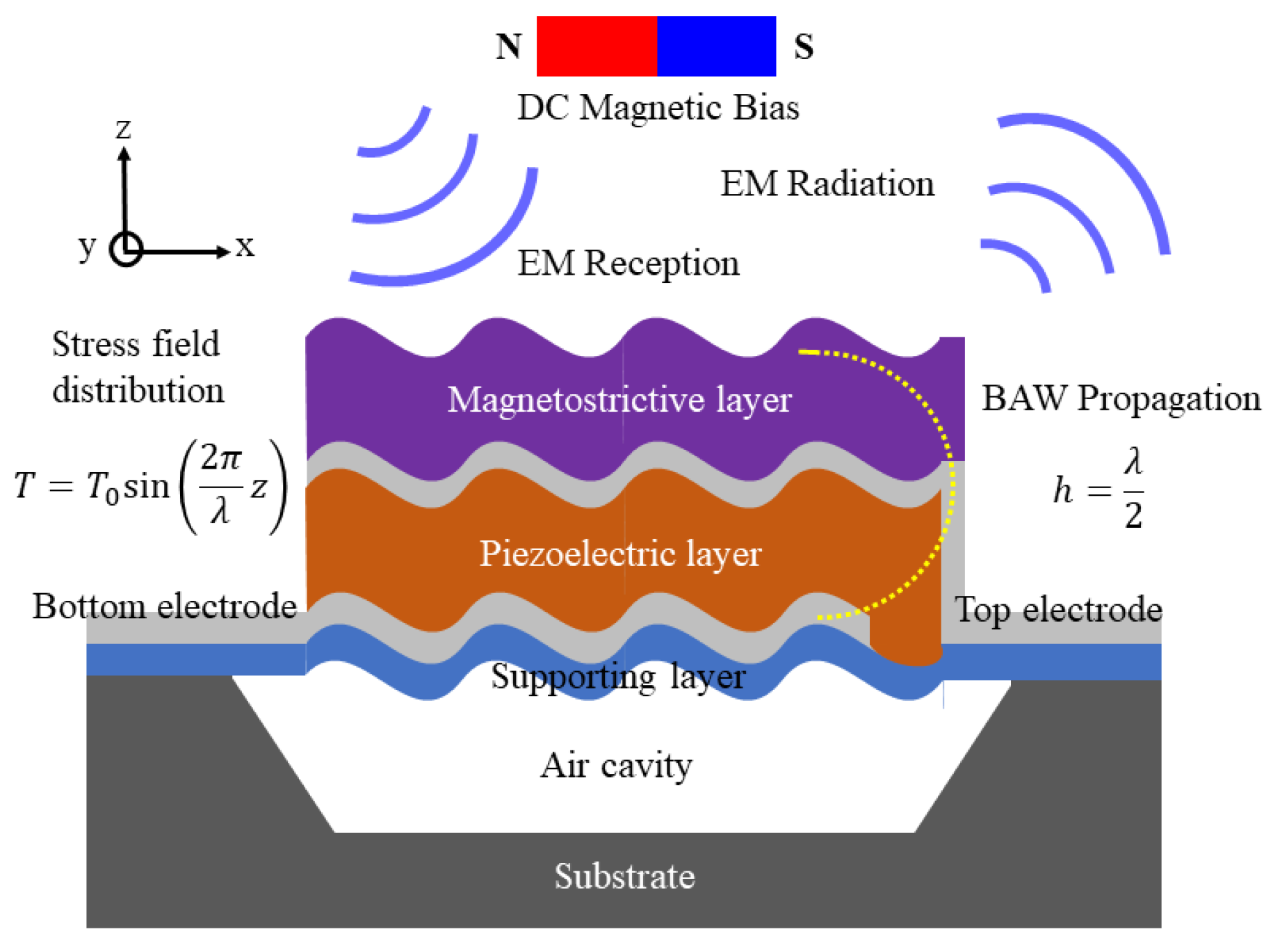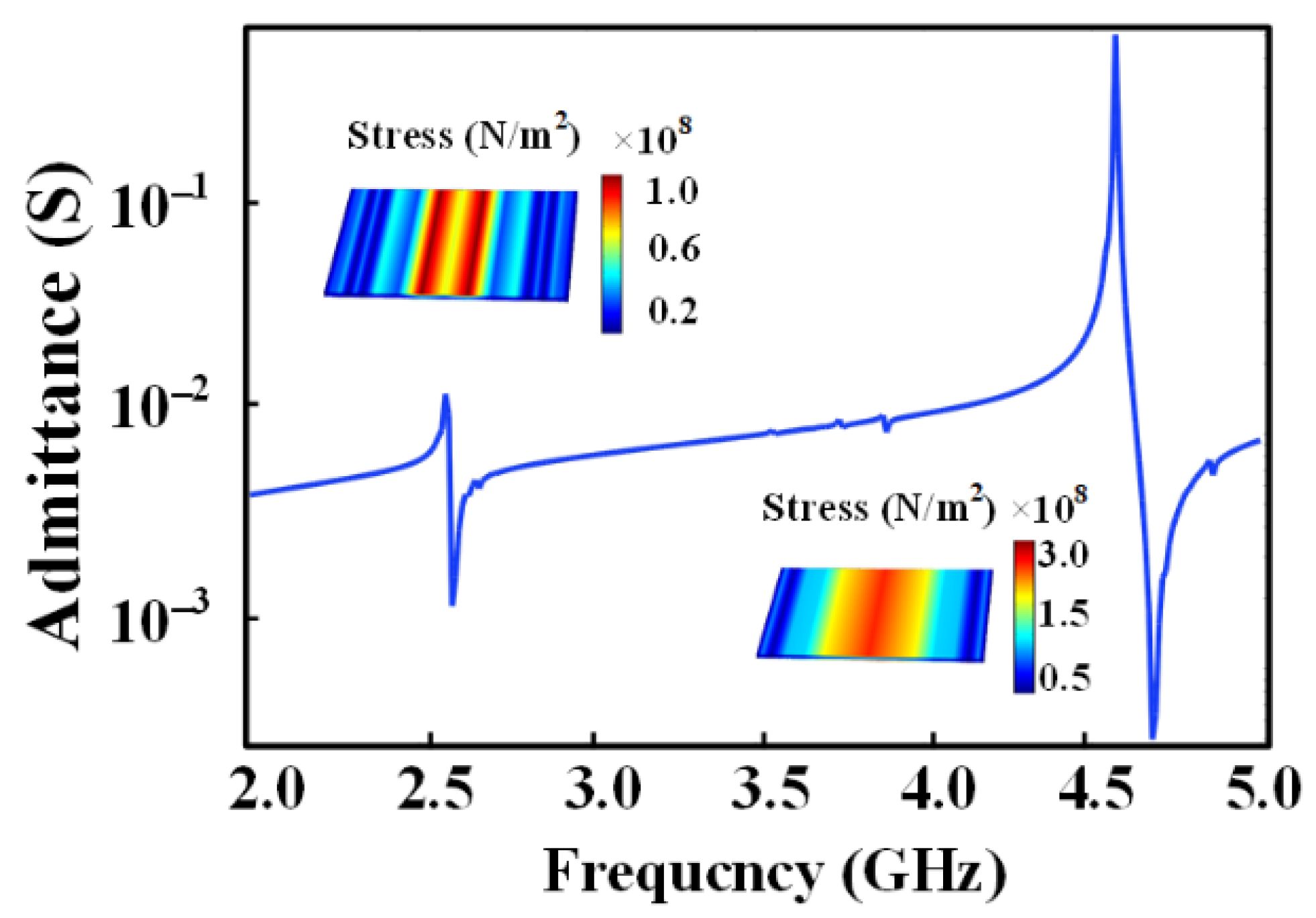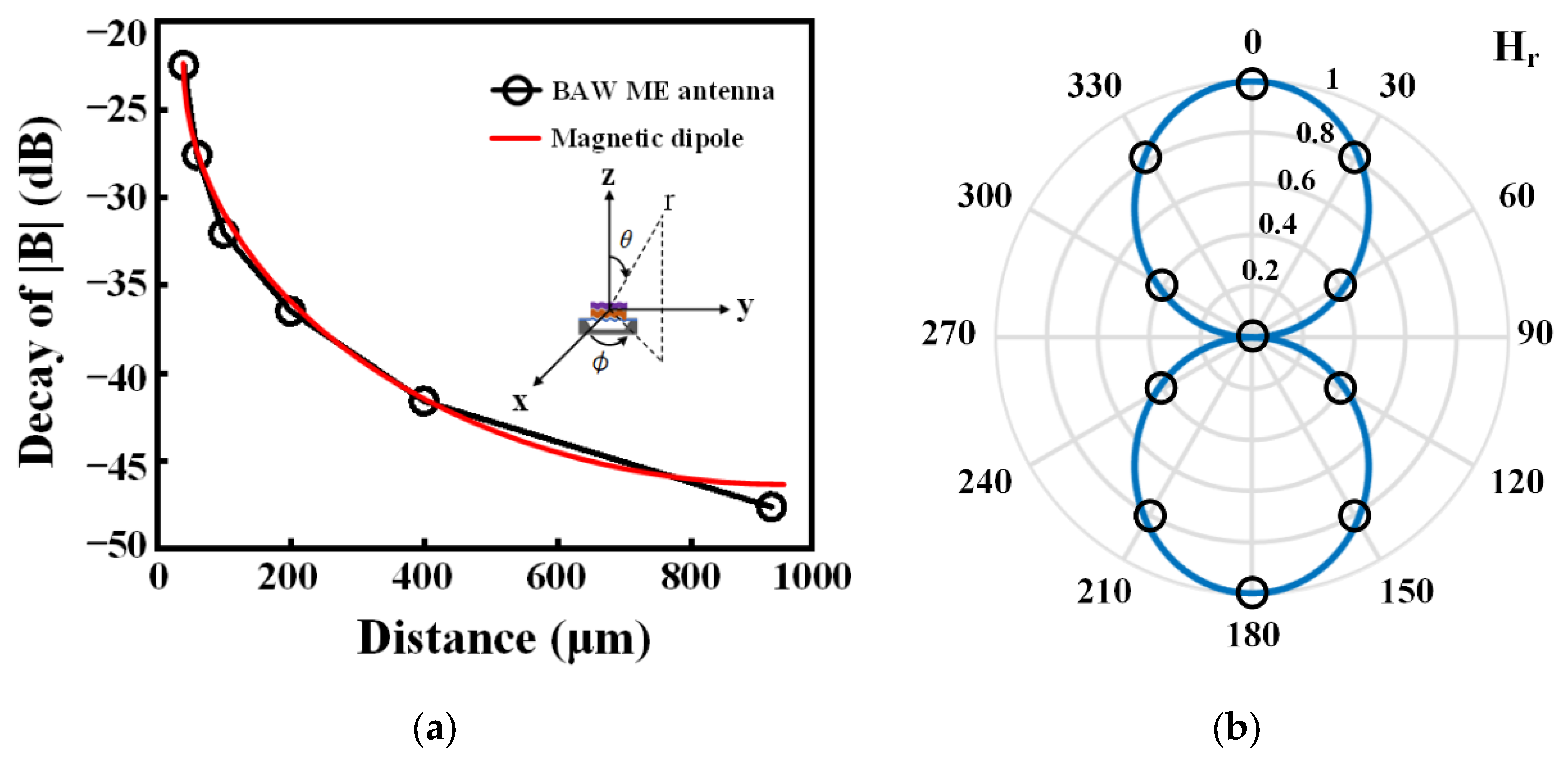A Micromechanical Transmitter with Only One BAW Magneto-Electric Antenna
Abstract
:1. Introduction
2. BAW ME Transmitter
2.1. Fundamentals of Radio Transmitters
2.2. Oscillator and Modulator
2.3. Power Amplifier (PA)
3. Simulation of Transmission Process
4. Conclusions
Author Contributions
Funding
Conflicts of Interest
References
- Liu, C.; Zhang, Y.; Liu, X. Circularly polarized implantable antenna for 915 MHz ISM-Band far-field wireless power transmission. IEEE Antennas Wirel. Propag. Lett. 2018, 17, 373–376. [Google Scholar] [CrossRef]
- Singer, A.; Dutta, S.; Lewis, E.; Chen, Z.; Chen, J.C.; Verma, N.; Avants, B.; Feldman, A.K.; O’Malley, J.; Beierlein, M.; et al. Magnetoelectric materials for miniature, wireless neural stimulation at therapeutic frequencies. Neuron 2018, 107, 631–643.e5. [Google Scholar] [CrossRef]
- He, W.; Yang, A. A shear-mode piezoelectric heterostructure for electric current sensing in electric power grids. Micromachines 2019, 10, 421. [Google Scholar] [CrossRef] [PubMed] [Green Version]
- Kim, J.; Rahmat-Samii, Y. Implanted antennas inside a human body: Simulations, designs, and characterizations. IEEE Trans. Microw. Theory Tech. 2004, 52, 1934–1943. [Google Scholar] [CrossRef]
- Kiourti, A.; Psathas, K.A.; Nikita, K.S. Implantable and ingestible medical devices with wireless telemetry functionalities: A review of current status and challenges. Bioelectromagnetics 2014, 35, 1–15. [Google Scholar] [CrossRef]
- Stoecklin, S.; Yousaf, A.; Volk, T.; Reindl, L. Efficient wireless powering of biomedical sensor systems for multichannel brain implants. IEEE Trans. Instrum. Meas. 2016, 65, 754–764. [Google Scholar] [CrossRef]
- Faisal, F.; Yoo, H. A miniaturized novel-shape dual-band antenna for implantable applications. IEEE Trans. Antennas Propag. 2019, 67, 774–783. [Google Scholar] [CrossRef]
- Zhang, H.; Li, L.; Liu, C.; Guo, Y.X.; Wu, S. Miniaturized implantable antenna integrated with split resonate rings for wireless power transfer and data telemetry. Microw. Opt. Technol. Lett. 2017, 59, 710–714. [Google Scholar] [CrossRef]
- Xu, L.J.; Guo, Y.X.; Wu, W. Miniaturized dual-band antenna for implantable wireless communications. IEEE Antennas Wirel. Propag. Lett. 2014, 13, 1160–1163. [Google Scholar]
- Johansson, A.J. Wireless Communication with Medical Implants: Antennas and Propagation. Ph.D. Thesis, Lund University, Scania, Sweden, 2004. [Google Scholar]
- Sauer, C.; Stanacevic, M.; Cauwenberghs, G.; Thakor, N. Power harvesting and telemetry in CMOS for implanted devices. IEEE Trans. Circuits Syst. 2005, 52, 2605–2613. [Google Scholar] [CrossRef]
- Moradian, S.; Akhkandi, P.; Huang, J.; Gong, X.; Abdolvand, R. A battery-less wireless respiratory sensor using micro-machined thin-film piezoelectric resonators. Micromachines 2021, 12, 363. [Google Scholar] [CrossRef] [PubMed]
- Khalifa, A.; Liu, Y.; Karimi, Y.; Wang, Q.; Eisape, A.; Stanacevic, M.; Thakor, N.; Bao, Z.; Etienne-Cummings, R. The microbead: A 0.009 mm3 implantable wireless neural stimulator. IEEE Trans. Biomed. Circuits Syst. 2019, 13, 971–985. [Google Scholar] [CrossRef] [PubMed]
- Biederman, W.; Yeager, D.J.; Narevsky, N.; Koralek, A.C.; Carmena, J.M.; Alon, E.; Rabaey, J.M. A fully-integrated, miniaturized (0.125 mm2) 10.5 μW wireless neural sensor. IEEE J. Solid-State Circuits 2013, 48, 960–970. [Google Scholar] [CrossRef]
- Lee, S.; Cortese, A.J.; Gandhi, A.; Agger, E.R.; McEuen, P.L.; Molnar, A.C. A 250 μm × 57 μm microscale opto-electronically transduced electrodes (MOTEs) for neural recording. IEEE Trans. Biomed. Circuits Syst. 2019, 12, 1255–1256. [Google Scholar]
- Leung, V.W.; Lee, J.; Li, S.; Yu, S.; Kilfovle, C.; Larson, L.; Nurmikko, A.; Laiwalla, F. A CMOS distributed sensor system for high-density wireless neural implants for brain-machine interfaces. In Proceedings of the ESSCIRC 2018-IEEE 44th European Solid State Circuits Conference (ESSCIRC), Dresden, Germany, 3–6 September 2018; pp. 230–233. [Google Scholar]
- Yao, Z.; Wang, Y.E.; Keller, S.; Carman, G.P. Bulk Acoustic Wave-Mediated Multiferroic Antennas: Architecture and Performance Bound. IEEE Trans. Antennas Propag. 2015, 63, 3335–3344. [Google Scholar] [CrossRef]
- Nan, T.; Lin, H.; Gao, Y.; Matyushov, A.; Yu, G.; Chen, H.; Sun, N.; Wei, S.; Wang, Z.; Li, M.; et al. Acoustically actuated ultra-compact NEMS magnetoelectric antennas. Nat. Commun. 2017, 8, 296. [Google Scholar] [CrossRef]
- Zaeimbashi, M.; Nasrollahpour, M.; Khalifa, A.; Romano, A.; Liang, X.; Chen, H.; Sun, N.; Matyushov, A.; Lin, H.; Dong, C.; et al. Ultra-compact dual-band smart NEMS magnetoelectric antennas for simultaneous wireless energy harvesting and magnetic field sensing. Nat. Commun. 2021, 12, 3141. [Google Scholar] [CrossRef]
- Jensen, K.; Weldon, J.; Garcia, H.; Zettl, A. Nanotube Radio. Nano Lett. 2007, 7, 3508–3511. [Google Scholar] [CrossRef]
- Xu, G.; Xiao, S.; Li, Y.; Wang, B.Z. Modeling of electromagnetic radiation-induced from a magnetostrictive/piezoelectric laminated composite. Phys. Lett. A 2021, 385, 126959. [Google Scholar] [CrossRef]
- Yao, Z.; Tok, R.U.; Itoh, T.; Wang, Y.E. A Multiscale Unconditionally Stable Time-Domain (MUST) Solver Unifying Electrodynamics and Micromagnetics. IEEE Trans. Microw. Tech. 2018, 66, 2683–2696. [Google Scholar] [CrossRef]
- Li, J.; Peng, C.; Chen, S.; Gao, Y.; Ren, W.; He, X. Modeling and suppression of eddy current loss for BAW magnetoelectric devices. IEEE Trans. Magn. 2021, 57, 1–6. [Google Scholar] [CrossRef]
- Chavez, A.C.; Schneider, J.D.; Barra, A.; Tiwari, S.; Candler, R.N.; Carman, G.P. Voltage-controlled ferromagnetic resonance of dipole-coupled Co40Fe40B20 nanoellipses. Phys. Rev. Appl. 2019, 12, 044071. [Google Scholar] [CrossRef]
- Yao, Z.; Tiwari, S.; Lu, T.; Rivera, J.; Luong, K.Q.T.; Candler, R.N.; Carman, G.P.; Wang, Y.E. Modeling of Multiple Dynamics in the Radiation of Bulk Acoustic Wave Antennas. IEEE J. Multiscale Multiphys. Comput. Tech. 2020, 5, 5–18. [Google Scholar] [CrossRef]







Publisher’s Note: MDPI stays neutral with regard to jurisdictional claims in published maps and institutional affiliations. |
© 2022 by the authors. Licensee MDPI, Basel, Switzerland. This article is an open access article distributed under the terms and conditions of the Creative Commons Attribution (CC BY) license (https://creativecommons.org/licenses/by/4.0/).
Share and Cite
Chen, S.; Li, J.; Gao, Y.; Li, J.; Dong, H.; Gu, Z.; Ren, W. A Micromechanical Transmitter with Only One BAW Magneto-Electric Antenna. Micromachines 2022, 13, 272. https://doi.org/10.3390/mi13020272
Chen S, Li J, Gao Y, Li J, Dong H, Gu Z, Ren W. A Micromechanical Transmitter with Only One BAW Magneto-Electric Antenna. Micromachines. 2022; 13(2):272. https://doi.org/10.3390/mi13020272
Chicago/Turabian StyleChen, Si, Junru Li, Yang Gao, Jianbo Li, Hongmei Dong, Zhijun Gu, and Wanchun Ren. 2022. "A Micromechanical Transmitter with Only One BAW Magneto-Electric Antenna" Micromachines 13, no. 2: 272. https://doi.org/10.3390/mi13020272
APA StyleChen, S., Li, J., Gao, Y., Li, J., Dong, H., Gu, Z., & Ren, W. (2022). A Micromechanical Transmitter with Only One BAW Magneto-Electric Antenna. Micromachines, 13(2), 272. https://doi.org/10.3390/mi13020272





